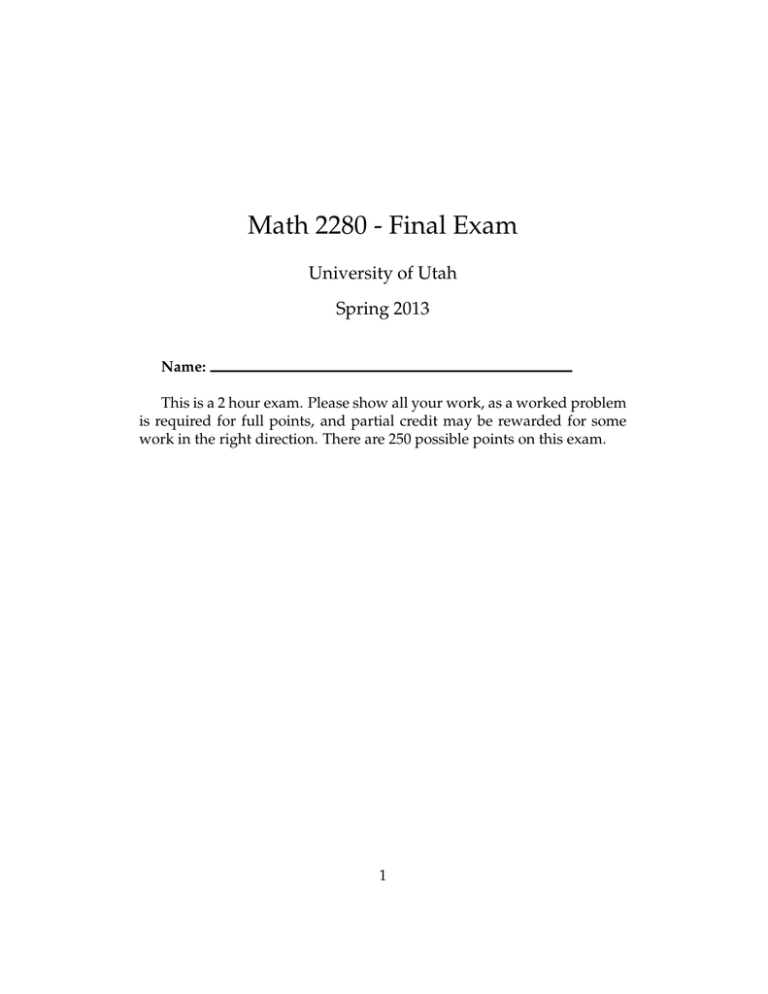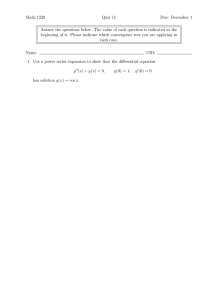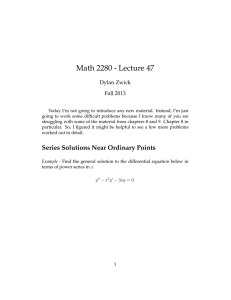Math 2280 - Final Exam University of Utah Spring 2013
advertisement

Math 2280 - Final Exam
University of Utah
Spring 2013
Name:
This is a 2 hour exam. Please show all your work, as a worked problem
is required for full points, and partial credit may be rewarded for some
work in the right direction. There are 250 possible points on this exam.
1
Things You Might Want to Know
Definitions
Z ∞
L(f (t)) =
e−st f (t)dt.
0
f (t) ∗ g(t) =
Z
0
t
f (τ )g(t − τ )dτ .
Laplace Transforms
L(tn ) =
n!
sn+1
1
s−a
k
L(sin (kt)) = 2
s + k2
s
L(cos (kt)) = 2
s + k2
L(eat ) =
L(δ(t − a)) = e−as
L(u(t − a)f (t − a)) = e−as F (s).
Translation Formula
L(eat f (t)) = F (s − a).
Derivative Formula
L(x(n) ) = sn X(s) − sn−1 x(0) − sn−2 x′ (0) − · · · − sx(n−2) (0) − x(n−1) (0).
2
Fourier Series Definition
For a function f (t) of period 2L the Fourier series is:
∞ a0 X
nπt
nπt
+ bn sin
.
+
an cos
2
L
L
n=1
L
nπt
dt
f (t) cos
L
−L
Z
1 L
nπt
bn =
dt.
f (t) sin
L −L
L
1
an =
L
Z
3
1. Basic Definitions (10 points)
Circle or state the correct answer to the questions about the following
differential equation:
√
xy (5) − x2 (y ′)2 + ex y = cos x
(2 point) The differential equation is:
Linear
Nonlinear
(2 points) The order of the differential equation is:
For the differential equation:
x2 y ′′ + xy ′ − y = sin (ex
(2 point) The differential equation is:
2 +5x+2
)
Linear
Nonlinear
(2 point) The order of the differential equation is:
(2 point) The corresponding homogeneous equation is:
4
2. Phase Diagrams (15 points)
For the autonomous differential equation:
dx
= 3x − x2
dt
Find all critical points, draw the corresponding phase diagram, and
indicate whether the critical points are stable, unstable, or semi-stable.
5
3. Ordinary Points, Regular Singular Points, and Irregular Singular
Points (15 points)
Determine if x = 0 is an ordinary, regular singular, or irregular singular point in each of the following differential equations:
a) (5 points)
x(1 + x)y ′′ + 2y ′ + 3xy = 0
b) (5 points)
x3 y ′′ + 2x2 y ′ + 7y = 0
6
c) (5 points)
x(1 − x)(1 + x)y ′′ + x2 y ′ + x3 y = 0
7
4. Indicial Equations (15 points)
What are the roots of the indicial equation for the regular singular
differential equation:
x2 y ′′ + 3(sin x)y ′ + ex y = 0.
Will the method of Frobenius be guaranteed to yield two linearly
independent solutions? Could it possibly yield two linearly independent solutions? Why or why not?1
1
Note - You aren’t expected to find the solutions here.
8
5. Undetermined Coefficients (10 points)
What is the form of the particular solution to the following differential equation:
y (3) + y ′′ + y ′ + y = x2 e−5x sin (3x),
using the method of undetermined coefficients?2
2
You don’t have to solve the differential equation, nor do you have to find the coefficients! You just have to give the form of the particular solution dictated by the method of
undetermined coefficients.
9
6. Nonhomogeneous Linear Differential Equations with Constant Coefficients (30 points)
Find the general solution to the differential equation
y ′′ + 7y ′ + 12y = x + e−4x .
10
More room for this problem, if you need it.
11
7. Systems of Differential Equations (35 points)
Find the general solution to the system of differential equations
−2 −9 0
4 0 x
x′ = 1
1
3 1
12
More room for this problem, if you need it.
13
8. Laplace Transforms and Convolutions (15 points)
Using the definition of convolution, calculate the convolution of the
functions:
f (t) = t,
g(t) = et .
What is the Laplace transform of f (t) ∗ g(t)? In other words, what is
L(f (t) ∗ g(t))?3
3
If you try to answer this second question using the formal definition of the Laplace
transform, you’re doing it the hard way.
14
More room for the problem, if you need it.
15
9. Power Series (30 points)
Solve the following second-order ODE using power series methods:
(x2 + 2)y ′′ + 4xy ′ + 2y = 0.
16
More room for the problem, if you need it.
17
Even more room for the problem, if you need it.
18
10. Fourier Series (25 points)
The values of the periodic function f (t) in one full period are given.
Find the function’s Fourier series.
−1 −2 < t < 0
1
0<t<2
f (t) =
0 t = {−2, 0}
Extra Credit (5 points) - Use this solution and what you know about
Fourier series to deduce the famous Leibniz formula for π.
19
More room for the problem, if you need it.
20
11. Fixed Endpoint Problem (20 points)
For the fixed endpoint problem:
X ′′ + λX = 0,
X(0) = X(2) = 0;
what are the possible eigenvalues λn , and the corresponding eigenfunctions Xn ?
21
More room for the problem, if you need it.
22
12. The Heat Equation (30 points)
Solve the heat equation:
∂u
∂2u
= 2,
∂t
∂x
with the boundary values:
u(0, t) = u(2, t) = 0,
1 0<x<2
u(x, 0) =
0 x = {0, 2}
Note - The solutions to the last two problems might be useful to you
here.
23
More room for the problem, if you need it.
24
Even more room for the problem, if you need it.
25



